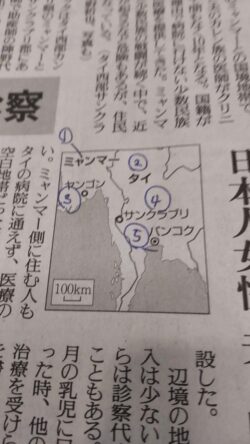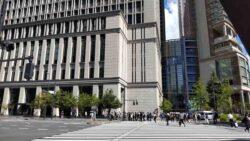Lack of wheels for tourists keeps Okinawa recovery from getting into gear

Kenichi Uchiyama talks about missing out on the full effects of the recovery from the pandemic as he stows diving gear at his shop in Motobu, Okinawa Prefecture, on Aug. 29.
6:00 JST, September 9, 2022
The tourists flocking back to Okinawa Prefecture this summer are no longer under the pandemic restrictions of the past three years, allowing them to move about freely. The ones that are able to, that is.
A shortage of rental cars is only one area of the problems in the prefecture’s fragile transportation infrastructure that are affecting its vital tourism industry.
Candidates in the upcoming Okinawa gubernatorial election have made revitalizing tourism a key issue, putting utmost importance on coming up with a strategy to smooth out the bumps in the infrastructure road.
Kenichi Uchiyama, who runs a diving goods shop in Motobu, a town in the northern part of Okinawa Island, is feeling the pinch first hand.
“While many more tourists could have come, it doesn’t mean anything if they don’t have a means of transportation,” Uchiyama, 42, said on Aug. 29 as he stowed away gear due to the approach of Typhoon No. 11, the clear blue sea glistening nearby.
The distance from Naha Airport to the town as the crow flies is more than 50 kilometers, and most of Uchiyama’s customers come in rental cars. But the shortage of rentals is dealing the northern part of the island a severe blow.
This summer, the number of customers to Uchiyama’s shop recovered to about 80% of pre-pandemic levels, but he said that many tourists used shops around Naha because they could not get rental cars.
Okinawa Prefecture is almost completely dependent on cars for everyday life. There are no railway lines, save for a single monorail that connects Naha Airport with the city center and Urasoe City.
The rental car business is a key pillar of the prefecture’s tourism industry, but when tourist numbers plunged during the pandemic, rental car companies began selling off cars as a cost-cutting measure.
Even as tourist numbers started to recover, it was difficult to stock up on cars so quickly, which created a “rental car refugee” phenomenon of tourists left stranded.
Motobu and other municipalities far from the airport operate free buses connecting hotels and tourist spots. The towns made it possible to transfer from expressway coaches to the buses, but “The service is not widely known, and so the effect on luring tourists is limited,” lamented one official.
Even if tourists opt for taxis, their numbers have also declined because elderly drivers and others have been leaving the business. It has produced a paradox in which the tourism industry is getting the demand it so desperately needs, but is unable to sufficiently meet it.
To overcome the shortcomings in the industry, one company has turned to IT.
In July, OTS Service Management Research & Consulting Inc., a Naha-based tourism consulting firm, and its business partners launched a website called Okinawa Compass, which offers tourism information about hotels, restaurants and other destinations that match the preferences of the user.
The website also proposes transportation options to users, and there are plans to incorporate MaaS (Mobility as a Service), which is seen as a next-generation mobile service that will allow users to make reservations on smartphone screens.
The company’s aim is to enable tourists to smoothly transfer from the monorail, expressway buses and other means of public transportation, thus enhancing convenience and mobility during their trip.
“Unless we change the way of doing things from prior to the pandemic, the tourism industry [in Okinawa] can not survive,” said OTS President Masahisa Yamada, 57.
In the gubernatorial election campaigns, the three candidates made attracting tourists a key part of their platforms.
Mikio Shimoji vowed to “realize a goal of 20 million tourists,” Atsushi Sakima pledged to “provide ¥100 billion worth of support to the tourism industry,” and incumbent Denny Tamaki said he would “achieve ¥1.2 trillion in tourism income over the next 10 years.”
In terms of transportation policies, all three candidates brought up the building of a railway line that will run the length of Okinawa Island. But such a project has never been confirmed as feasible, and thus any strategy to change the current situation is not within sight.
“Though so much importance is placed on how to attract tourists from outside of the prefecture, the most urgent task is to overcome the fragile public transportation system,” said Prof. Kazuhiro Miyagi of Okinawa International University, an expert on Okinawa economic theory.
“In addition to infrastructure improvement over the mid- and long-term, it is necessary to take measures to disperse the effects of the recovery from the pandemic throughout the prefecture.”
"Society" POPULAR ARTICLE
JN ACCESS RANKING







